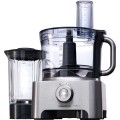Chopping bowl capacity
The capacity of the blender bowl determines how much consistency the device can prepare in one approach. The average blender has a capacity of 1.5 liters, which is quite optimal for making drinks and other textures for three people.
Blender capacity
The volume of the blender jar (see Blender) that the food processor is equipped with. Standardly, it is about one and a half liters; for a large family, it makes sense to select a larger capacity (about 2 liters), and 1 liter will be enough if a blender is rarely needed and for small quantities of the product.
Number of speeds
The number of fixed speeds of rotation of the attachments provided in the design of the food processor. The more of them, the more accurately you can choose the required speed for each specific mode of operation. It is worth noting that some devices do not have fixed speeds — the control is carried out smoothly (see Stepless speed controller)
Smooth speed control
A control that allows you to smoothly change the speed of rotation of the food processor engine — for more precise adjustment of speed and setting the optimal mode for different products. With stepwise speed control, a situation may arise when a higher speed value is already too high, and a lower speed is not yet enough.
Smooth control avoids such situations.
Body material
The main material used for the body of the unit.
—
Plastic. The main advantage of plastic is the relatively low cost. In addition, this material can have almost any colour, including quite bright ones. In terms of strength and reliability, the plastic is inferior to metal, but this difference does not play a special role in normal use, it becomes noticeable only in various emergency situations (during falls, overheating, etc.). Also, plastic bodies are relatively easy to scratch, but this point mainly affects the appearance of the unit and does not affect the functionality. In light of all this, only plastic is the most popular material for the bodies of modern food processors.
—
Metal. Metal bodies are distinguished by their solid appearance and high strength. On the other hand, this material is noticeably more expensive than plastic, and therefore is less common — mainly in middle and high class food processors.
Display
Availability of the display on the control panel makes operation of the device more simple and visual. Usually, the screen displays basic information about the operating modes used, and the display is also used for setting parameters.

